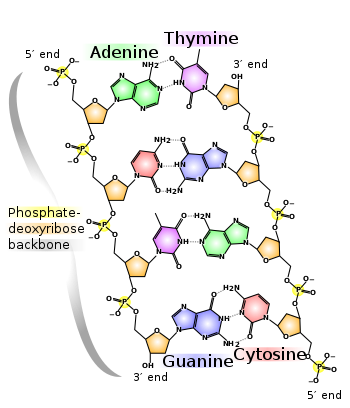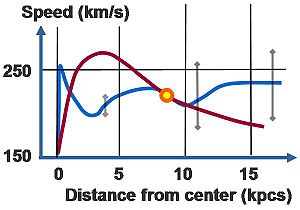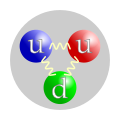Definitions
Common definition

The DNA molecule is an example of matter under the "atoms and molecules" definition.
The observation that matter occupies space goes back to antiquity. However, an explanation for why matter occupies space is recent, and is argued to be a result of the Pauli exclusion principle.[40][41] Two particular examples where the exclusion principle clearly relates matter to the occupation of space are white dwarf stars and neutron stars, discussed further below.
Relativity
In the context of relativity, mass is not a conserved quantity.[1] Thus, in relativity usually a more general view is taken that it is not mass, but the energy–momentum tensor that quantifies the amount of matter. Matter therefore is anything that contributes to the energy–momentum of a system, that is, anything that is not pure gravity.[42][43] This view is commonly held in fields that deal with general relativity such as cosmology.Atoms and molecules definition
A definition of "matter" that is based upon its physical and chemical structure is: matter is made up of atoms and molecules.[44] As an example, deoxyribonucleic acid molecules (DNA) are matter under this definition because they are made of atoms. This definition can be extended to include charged atoms and molecules, so as to include plasmas (gases of ions) and electrolytes (ionic solutions), which are not obviously included in the atoms and molecules definition. Alternatively, one can adopt the protons, neutrons and electrons definition.Protons, neutrons and electrons definition
A definition of "matter" more fine-scale than the atoms and molecules definition is: matter is made up of what atoms and molecules are made of, meaning anything made of protons, neutrons, and electrons.[45] This definition goes beyond atoms and molecules, however, to include substances made from these building blocks that are not simply atoms or molecules, for example white dwarf matter — typically, carbon and oxygen nuclei in a sea of degenerate electrons. At a microscopic level, the constituent "particles" of matter such as protons, neutrons and electrons obey the laws of quantum mechanics and exhibit wave–particle duality. At an even deeper level, protons and neutrons are made up of quarks and the force fields (gluons) that bind them together (see Quarks and leptons definition below).Quarks and leptons definition

Under the "quarks and leptons" definition, the elementary and composite particles made of the quarks (in purple) and leptons (in green) would be "matter"; while the gauge bosons (in red) would not be "matter". However, interaction energy inherent to composite particles (for example, gluons involved in neutrons and protons) contribute to the mass of ordinary matter.
Leptons (the most famous being the electron), and quarks (of which baryons, such as protons and neutrons, are made) combine to form atoms, which in turn form molecules. Because atoms and molecules are said to be matter, it is natural to phrase the definition as: ordinary matter is anything that is made of the same things that atoms and molecules are made of. (However, notice that one also can make from these building blocks matter that is not atoms or molecules.) Then, because electrons are leptons, and protons and neutrons are made of quarks, this definition in turn leads to the definition of matter as being "quarks and leptons", which are the two types of elementary fermions. Carithers and Grannis state: Ordinary matter is composed entirely of first-generation particles, namely the [up] and [down] quarks, plus the electron and its neutrino.[48] (Higher generations particles quickly decay into first-generation particles, and thus are not commonly encountered.[49])
This definition of ordinary matter is more subtle than it first appears. All the particles that make up ordinary matter (leptons and quarks) are elementary fermions, while all the force carriers are elementary bosons.[50] The W and Z bosons that mediate the weak force are not made of quarks or leptons, and so are not ordinary matter, even if they have mass.[51] In other words, mass is not something that is exclusive to ordinary matter.
The quark–lepton definition of ordinary matter, however, identifies not only the elementary building blocks of matter, but also includes composites made from the constituents (atoms and molecules, for example). Such composites contain an interaction energy that holds the constituents together, and may constitute the bulk of the mass of the composite. As an example, to a great extent, the mass of an atom is simply the sum of the masses of its constituent protons, neutrons and electrons. However, digging deeper, the protons and neutrons are made up of quarks bound together by gluon fields (see dynamics of quantum chromodynamics) and these gluons fields contribute significantly to the mass of hadrons.[52] In other words, most of what composes the "mass" of ordinary matter is due to the binding energy of quarks within protons and neutrons.[53] For example, the sum of the mass of the three quarks in a nucleon is approximately 12.5 MeV/c2, which is low compared to the mass of a nucleon (approximately 938 MeV/c2).[49][54] The bottom line is that most of the mass of everyday objects comes from the interaction energy of its elementary components.
Smaller building blocks?
The Standard Model groups matter particles into three generations, where each generation consists of two quarks and two leptons. The first generation is the up and down quarks, the electron and the electron neutrino; the second includes the charm and strange quarks, the muon and the muon neutrino; the third generation consists of the top and bottom quarks and the tau and tau neutrino.[55] The most natural explanation for this would be that quarks and leptons of higher generations are excited states of the first generations. If this turns out to be the case, it would imply that quarks and leptons are composite particles, rather than elementary particles.[56]Structure
In particle physics, fermions are particles which obey Fermi–Dirac statistics. Fermions can be elementary, like the electron, or composite, like the proton and the neutron. In the Standard Model there are two types of elementary fermions: quarks and leptons, which are discussed next.Quarks
Main article: Quark
Quarks are a particles of spin-1⁄2, implying that they are fermions. They carry an electric charge of −1⁄3 e (down-type quarks) or +2⁄3 e (up-type quarks). For comparison, an electron has a charge of −1 e. They also carry colour charge, which is the equivalent of the electric charge for the strong interaction. Quarks also undergo radioactive decay, meaning that they are subject to the weak interaction. Quarks are massive particles, and therefore are also subject to gravity.| name | symbol | spin | electric charge (e) | mass (MeV/c2) | mass comparable to | antiparticle | antiparticle symbol |
|---|---|---|---|---|---|---|---|
| up-type quarks | |||||||
| up | u | 1⁄2 | +2⁄3 | 1.5 to 3.3 | ~ 5 electrons | antiup | u |
| charm | c | 1⁄2 | +2⁄3 | 1160 to 1340 | ~ 1 proton | anticharm | c |
| top | t | 1⁄2 | +2⁄3 | 169,100 to 173,300 | ~ 180 protons or ~ 1 tungsten atom | antitop | t |
| down-type quarks | |||||||
| down | d | 1⁄2 | −1⁄3 | 3.5 to 6.0 | ~ 10 electrons | antidown | d |
| strange | s | 1⁄2 | −1⁄3 | 70 to 130 | ~ 200 electrons | antistrange | s |
| bottom | b | 1⁄2 | −1⁄3 | 4130 to 4370 | ~ 5 protons | antibottom | b |
Baryonic matter
Main article: Baryon
Baryons are strongly interacting fermions, and so are subject to Fermi-Dirac statistics. Amongst the baryons are the protons and neutrons, which occur in atomic nuclei, but many other unstable baryons exist as well. The term baryon is usually used to refer to triquarks — particles made of three quarks. "Exotic" baryons made of four quarks and one antiquark are known as the pentaquarks, but their existence is not generally accepted.Baryonic matter is the part of the universe that is made of baryons (including all atoms). This part of the universe does not include dark energy, dark matter, black holes or various forms of degenerate matter, such as compose white dwarf stars and neutron stars. Microwave light seen by Wilkinson Microwave Anisotropy Probe (WMAP), suggests that only about 4.6% of that part of the universe within range of the best telescopes (that is, matter that may be visible because light could reach us from it), is made of baryionic matter. About 23% is dark matter, and about 72% is dark energy.[58]

A comparison between the white dwarf IK Pegasi B (center), its A-class companion IK Pegasi A (left) and the Sun (right). This white dwarf has a surface temperature of 35,500 K.
Degenerate matter
Main article: Degenerate matter
In physics, degenerate matter refers to the ground state of a gas of fermions at a temperature near absolute zero.[59] The Pauli exclusion principle requires that only two fermions can occupy a quantum state, one spin-up and the other spin-down. Hence, at zero temperature, the fermions fill up sufficient levels to accommodate all the available fermions, and for the case of many fermions the maximum kinetic energy called the Fermi energy and the pressure of the gas becomes very large and dependent upon the number of fermions rather than the temperature, unlike normal states of matter.Degenerate matter is thought to occur during the evolution of heavy stars.[60] The demonstration by Subrahmanyan Chandrasekhar that white dwarf stars have a maximum allowed mass because of the exclusion principle caused a revolution in the theory of star evolution.[61]
Degenerate matter includes the part of the universe that is made up of neutron stars and white dwarfs.
Strange matter
Main article: Strange matter
Strange matter is a particular form of quark matter, usually thought of as a 'liquid' of up, down, and strange quarks. It is to be contrasted with nuclear matter, which is a liquid of neutrons and protons (which themselves are built out of up and down quarks), and with non-strange quark matter, which is a quark liquid containing only up and down quarks. At high enough density, strange matter is expected to be color superconducting. Strange matter is hypothesized to occur in the core of neutron stars, or, more speculatively, as isolated droplets that may vary in size from femtometers (strangelets) to kilometers (quark stars).[edit] Two meanings of the term "strange matter"
In particle physics and astrophysics, the term is used in two ways, one broader and the other more specific.- The broader meaning is just quark matter that contains three flavors of quarks: up, down, and strange. In this definition, there is a critical pressure and an associated critical density, and when nuclear matter (made of protons and neutrons) is compressed beyond this density, the protons and neutrons dissociate into quarks, yielding quark matter (probably strange matter).
- The narrower meaning is quark matter that is more stable than nuclear matter. The idea that this could happen is the "strange matter hypothesis" of Bodmer [62] and Witten.[63] In this definition, the critical pressure is zero: the true ground state of matter is always quark matter. The nuclei that we see in the matter around us, which are droplets of nuclear matter, are actually metastable, and given enough time (or the right external stimulus) would decay into droplets of strange matter, i.e. strangelets.
[edit] Leptons
Main article: Lepton
Leptons are a particles of spin-1⁄2, meaning that they are fermions. They carry an electric charge of −1 e (charged leptons) or 0 e (neutrinos). Unlike quarks, leptons do not carry colour charge, meaning that they do not experience the strong interaction. Leptons also undergo radioactive decay, meaning that they are subject to the weak interaction. Leptons are massive particles, therefore are subject to gravity.| name | symbol | spin | electric charge (e) | mass (MeV/c2) | mass comparable to | antiparticle | antiparticle symbol |
|---|---|---|---|---|---|---|---|
| charged leptons[64] | |||||||
| electron | e− | 1⁄2 | −1 | 0.5110 | 1 electron | antielectron | e+ |
| muon | μ− | 1⁄2 | −1 | 105.7 | ~ 200 electrons | antimuon | μ+ |
| tau | τ− | 1⁄2 | −1 | 1,777 | ~ 2 protons | antitau | τ+ |
| neutrinos[65] | |||||||
| electron neutrino | νe | 1⁄2 | 0 | < 0.000460 | < 1⁄1000 electron | electron antineutrino | νe |
| muon neutrino | νμ | 1⁄2 | 0 | < 0.19 | < 1⁄2 electron | muon antineutrino | νμ |
| tau neutrino | ντ | 1⁄2 | 0 | < 18.2 | < 40 electrons | tau antineutrino | ντ |
Phases
Main article: Phase (matter)
See also: Phase diagram and State of matter

Phase diagram for a typical substance at a fixed volume. Vertical axis is Pressure, horizontal axis is Temperature. The green line marks the freezing point (above the green line is solid, below it is liquid) and the blue line the boiling point (above it is liquid and below it is gas). So, for example, at higher T, a higher P is necessary to maintain the substance in liquid phase. At the triple point the three phases; liquid, gas and solid; can coexist. Above the critical point there is no detectable difference between the phases. The dotted line shows the anomalous behavior of water: ice melts at constant temperature with increasing pressure.[66]
Phases are sometimes called states of matter, but this term can lead to confusion with thermodynamic states. For example, two gases maintained at different pressures are in different thermodynamic states (different pressures), but in the same phase (both are gases).
Antimatter
Main article: Antimatter
| Baryon asymmetry. Why is there far more matter than antimatter in the observable universe? |
Antimatter is not found naturally on Earth, except very briefly and in vanishingly small quantities (as the result of radioactive decay or cosmic rays). This is because antimatter which came to exist on Earth outside the confines of a suitable physics laboratory would almost instantly meet the ordinary matter that Earth is made of, and be annihilated. Antiparticles and some stable antimatter (such as antihydrogen) can be made in tiny amounts, but not in enough quantity to do more than test a few of its theoretical properties.
There is considerable speculation both in science and science fiction as to why the observable universe is apparently almost entirely matter, and whether other places are almost entirely antimatter instead. In the early universe, it is thought that matter and antimatter were equally represented, and the disappearance of antimatter requires an asymmetry in physical laws called the charge parity (or CP symmetry) violation. CP symmetry violation can be obtained from the Standard Model,[69] but at this time the apparent asymmetry of matter and antimatter in the visible universe is one of the great unsolved problems in physics. Possible processes by which it came about are explored in more detail under baryogenesis.
Other types of matter

Pie chart showing the fractions of energy in the universe contributed by different sources. Ordinary matter is divided into luminous matter (the stars and luminous gases and 0.005% radiation) and nonluminous matter (intergalactic gas and about 0.1% neutrinos and 0.04% supermassive black holes). Ordinary matter is uncommon. Modeled after Ostriker and Steinhardt.[70] For more information, see NASA.

Galaxy rotation curve for the Milky Way. Vertical axis is speed of rotation about the galactic center. Horizontal axis is distance from the galactic center. The sun is marked with a yellow ball. The observed curve of speed of rotation is blue. The predicted curve based upon stellar mass and gas in the Milky Way is red. The difference is due to dark matter or perhaps a modification of the law of gravity.[75][76][77] Scatter in observations is indicated roughly by gray bars.
] Dark matter
See also: Galaxy formation and evolution and Dark matter halo
In astrophysics and cosmology, dark matter is matter of unknown composition that does not emit or reflect enough electromagnetic radiation to be observed directly, but whose presence can be inferred from gravitational effects on visible matter.[11][78] Observational evidence of the early universe and the big bang theory require that this matter have energy and mass, but is not composed of either elementary fermions (as above) OR gauge bosons. The commonly accepted view is that most of the dark-matter is non-baryonic in nature.[11] As such, it is composed of particles as yet unobserved in the laboratory. Perhaps they are supersymmetric particles,[79] which are not Standard Model particles, but relics formed at very high energies in the early phase of the universe and still floating about.


No comments:
Post a Comment